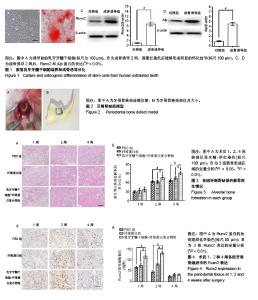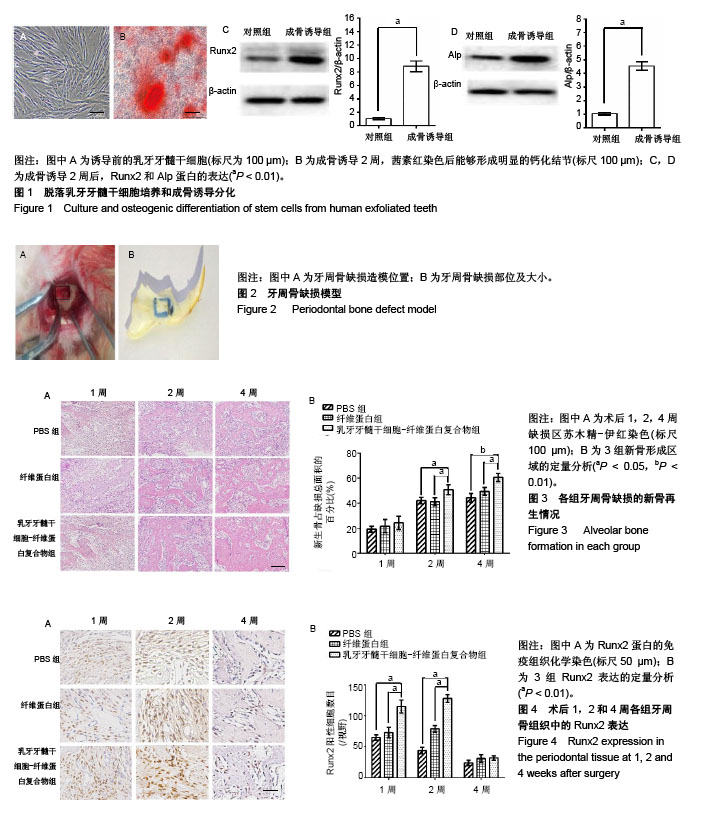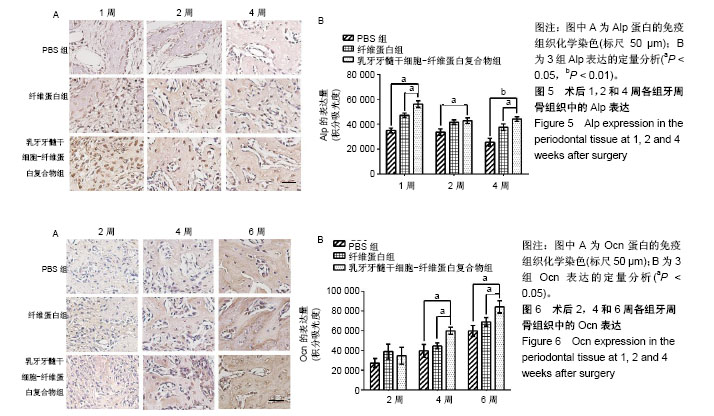| [1] 王新,谢富强,张贇,等. 骨形态发生蛋白-α-氰基丙烯酸复合生物胶修复大鼠下颌骨骨缺损的研究[J].中国组织工程研究, 2012,16(43): 7986-7990.[2] Kato H, Matsuoka K, Kato N, et al. Mandibular osteomyelitis and fracture successfully treated with vascularised iliac bone graft in a patient with pycnodysostosis. Br J Plast Surg. 2005;58(2):263-266.[3] 林泓兵,赵斌,丁子清,等.生物活性复合膜对大鼠牙周组织缺损的修复作用[J].吉林大学学报:医学版,2013,39(5):888-892. [4] 文军.改良富血小板血浆对乳牙牙髓干细胞增殖和成骨分化的作用研究[D].广东:南方医科大学,2014.[5] 郭皓.脱落乳牙牙髓干细胞聚合体用于牙髓再生的实验研究[D].西安:第四军医大学,2015.[6] Miura M, Gronthos S, Zhao M, et al. SHED: stem cells from human exfoliated deciduous teeth. Proc Natl Acad Sci U S A. 2003;100(10): 5807-5812.[7] Morsczeck C, Völlner F, Saugspier M, et al. Comparison of human dental follicle cells (DFCs) and stem cells from human exfoliated deciduous teeth (SHED) after neural differentiation in vitro. Clin Oral Investig. 2010;14(4):433-440.[8] Ma L, Makino Y, Yamaza H, et al. Cryopreserved dental pulp tissues of exfoliated deciduous teeth is a feasible stem cell resource for regenerative medicine. PLoS One. 2012;7(12): e51777.[9] Nourbakhsh N, Soleimani M, Taghipour Z, et al. Induced in vitro differentiation of neural-like cells from human exfoliated deciduous teeth-derived stem cells. Int J Dev Biol. 2011;55(2): 189-195.[10] Eslaminejad MB, Vahabi S, Shariati M, et al. In vitro Growth and Characterization of Stem Cells from Human Dental Pulp of Deciduous Versus Permanent Teeth. J Dent (Tehran). 2010;7(4): 185-195.[11] Seo BM, Sonoyama W, Yamaza T, et al. SHED repair critical-size calvarial defects in mice. Oral Dis. 2008;14(5): 428-434.[12] Zheng Y, Liu Y, Zhang CM, et al. Stem cells from deciduous tooth repair mandibular defect in swine. J Dent Res. 2009; 88(3):249-254.[13] 杨斯惠,钟良军,张鹏涛,等.小型猪自体牙周膜干细胞与复合材料修复牙周骨缺损[J].中国组织工程研究, 2013,17(16): 2851-2858.[14] Ho W, Tawil B, Dunn JC, et al. The behavior of human mesenchymal stem cells in 3D fibrin clots: dependence on fibrinogen concentration and clot structure. Tissue Eng. 2006;12(6): 1587-1595.[15] Catelas I, Sese N, Wu BM, et al. Human mesenchymal stem cell proliferation and osteogenic differentiation in fibrin gels in vitro. Tissue Eng. 2006;12(8):2385-2396.[16] Linsley C, Wu B, Tawil B. The effect of fibrinogen, collagen type I, and fibronectin on mesenchymal stem cell growth and differentiation into osteoblasts. Tissue Eng Part A. 2013; 19(11-12): 1416-1423.[17] 张男,王伟,陈保兴,等.人体牙髓干细胞的分离与鉴定[J].中华细胞与干细胞杂志(电子版),2014,4(3):32-35.[18] 聂利.BMP9基因修饰的牙囊干细胞治疗大鼠牙周骨缺损的体内实验研究[D].重庆:重庆医科大学,2017.[19] Zhang N, Chen B, Wang W, et al. Isolation, characterization and multi-lineage differentiation of stem cells from human exfoliated deciduous teeth. Mol Med Rep. 2016;14(1):95-102.[20] 张宇娜.牙本质细胞外基质蛋白对乳牙牙髓干细胞体外增殖、分化能力的影响[D].长春:吉林大学,2016.[21] Pierdomenico L, Bonsi L, Calvitti M, et al. Multipotent mesenchymal stem cells with immunosuppressive activity can be easily isolated from dental pulp. Transplantation. 2005;80(6):836-842.[22] Yamaza T, Kentaro A, Chen C, et al. Immunomodulatory properties of stem cells from human exfoliated deciduous teeth. Stem Cell Res Ther. 2010;1(1):5.[23] 黄敏,颜洪.脂肪间充质干细胞条件培养液联合富血小板纤维蛋白修复小鼠皮肤损伤[J].中国组织工程研究,2019,23(1):18-23.[24] 周延民,付丽.富血小板纤维蛋白在口腔软硬组织再生中的作用[J].口腔医学,2018,38(11):961-965.[25] Abiraman S, Varma HK, Umashankar PR, et al. Fibrin glue as an osteoinductive protein in a mouse model. Biomaterials. 2002;23(14): 3023-3031.[26] Dragoo JL, Samimi B, Zhu M, et al. Tissue-engineered cartilage and bone using stem cells from human infrapatellar fat pads. J Bone Joint Surg Br. 2003;85(5):740-747.[27] 黄林剑,李辉,谢千阳,等.静压力下兔髁突软骨细胞 COL2A1、SOX9、COL1A1和ALP的表达变化[J]. 中国口腔颌面外科杂志, 2014,12(4): 295-300.[28] 李宏波,旦锋,阮文辉,等.MRI结合血清ALP、LDH检测在骨肉瘤早期诊断及预后评估的临床价值[J].中国CT和MRI杂志, 2018, 16(12): 133-135.[29] 王晓辉.血清SAA、BDNF、ALP水平与脑卒中后并发血管性认知功能障碍的关系[J].实验与检验医学,2018,36(5):749-751.[30] 李俊福,陈岱韻,姜娟,等.胶原蛋白海绵对拔牙创愈合过程中基因ALP表达的影响[J].泰山医学院学报,2018,39(10):1087-1089.[31] Yamaguchi A, Komori T, Suda T. Regulation of osteoblast differentiation mediated by bone morphogenetic proteins, hedgehogs, and Cbfa1. Endocr Rev. 2000;21(4):393-411.[32] 李娜,代晓霞.Runx2在骨形成中的作用及调控[J].国外医学(医学地理分册),2018,39(4):353-356.[33] 张麟,向楠,周广文,等.补肾化痰方对去势骨质疏松大鼠BMP2/Smad/ RUNX2信号通路及钙沉积的影响[J].中医药导报,2018, 24(18): 20-24.[34] Tsao YT, Huang YJ, Wu HH, et al. Osteocalcin Mediates Biomineralization during Osteogenic Maturation in Human Mesenchymal Stromal Cells. Int J Mol Sci. 2017;18(1): E159. [35] 任小华,韩红娟,吴浩.下颌单颗后牙即刻种植负载后种植体周围龈沟液TNF-α、IL-1β、TGFα及OCN的变化及意义[J].四川医学, 2018,39(8): 904-908.[36] 胡小刚,王红祥,王巧娥,等.tP1NP、OCN和β-CTX在骨质疏松性骨折和骨关节炎老年患者唑来膦酸治疗前后变化[J].临床和实验医学杂志, 2018,17(12):1299-1302.[37] 孙伟珊,霍少川,王晓东,等.仙灵骨葆胶囊对去势大鼠股骨组织形态计量学和OCN、Cbfα1 mRNA的影响[J].中国实用医药, 2017, 12(34): 193-196. |



